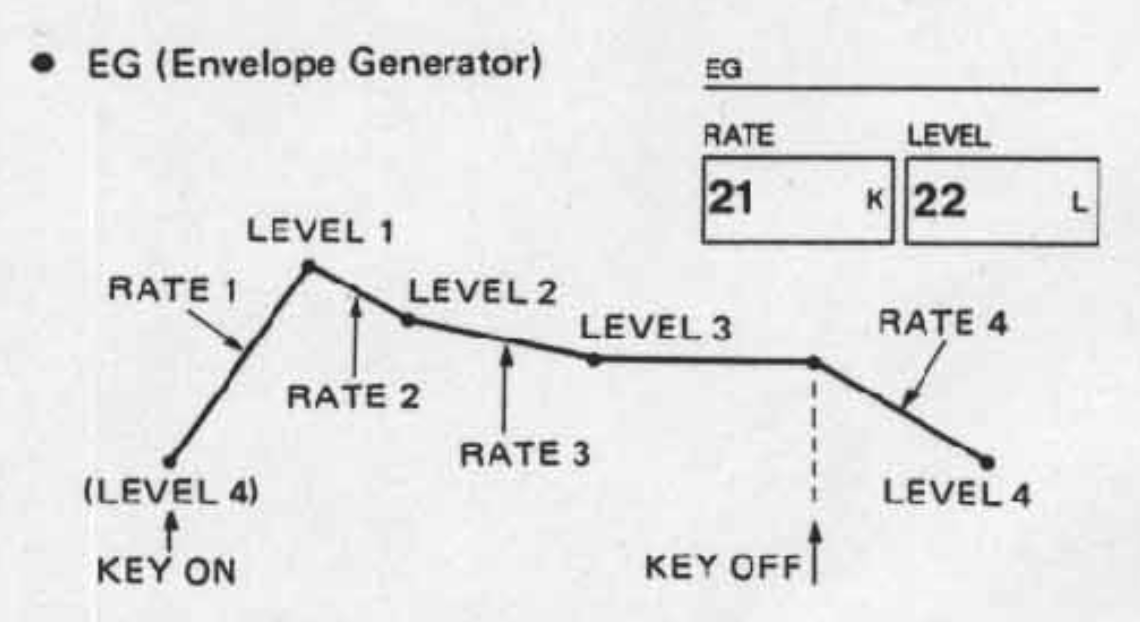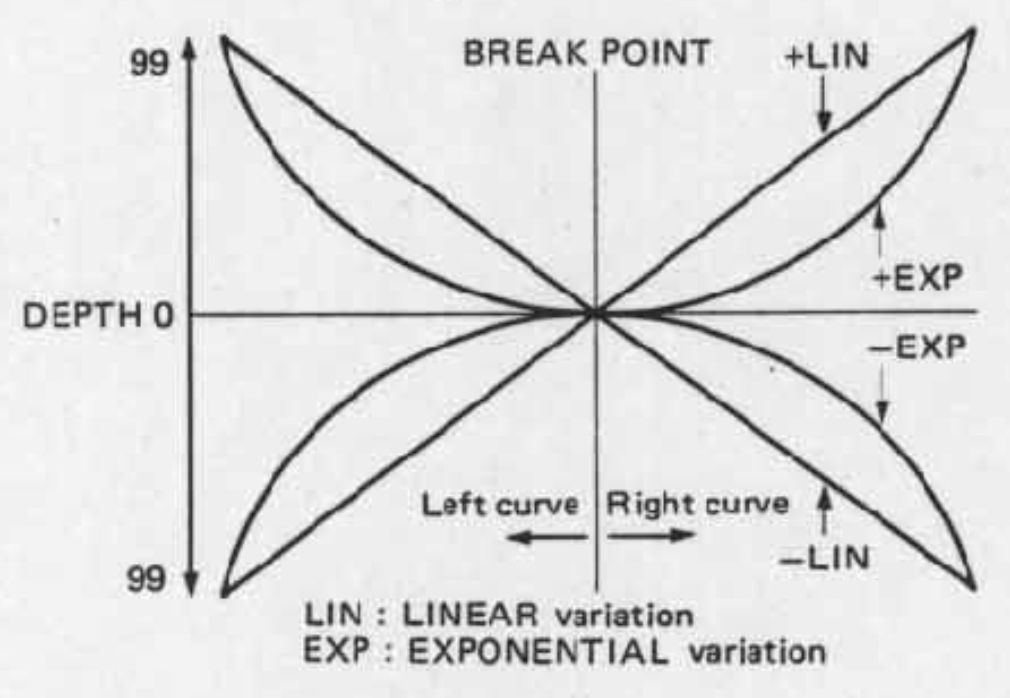DX7
DX7 tech specs
The DX7 was an FM synthesiser made by Yamaha in 1983.
There were several variations of this synth. Prototypes, organs, and preset-only piano-styled stage keyboards aside, these included the DX7, DX1, and DX5. Out of these, the DX7 was the simplest, the comparatively cheapest, and by far the most popular.
All three models have six operators (oscillators and envelope generators) per voice. The DX7 has sixteen voices, while the DX1 and DX5 have thirty-two, by combining two sets of oscillator and envelope generator chips.

Yamaha DX7 envelope graph
Further taking advantage of their digital nature, Yamaha gave these synths envelope generators that are much more versatile (and therefore harder to learn) than the conventional ADSR kind. They're more "attack, first decay, second decay, sustain, release"... although less prescriptive, as you can make subsequent levels higher than the first.

Yamaha DX7 keyboard level scaling graph
To make these synths even more versatile and complex, when it comes to using the pitch value to affect various parameters, this value can form a nonlinear curve, so instead of just forming a straight line on a graph, it can curve up or down either side of an arbitrary point.
FM synthesis is quite different to subtractive synthesis, more like an advanced version of additive synthesis. This means it can take a while to first wrap your head around it. But I think it has a somewhat unfair reputation for being very difficult to learn because, taking advantage of these synths being digital, Yamaha made the envelope generators and pitch tracking more versatile than anything else people were used to, so they had to learn three new things at once: FM synthesis, complex envelope generators, and nonlinear pitch tracking.
On top of that, in order to keep these mass produced synths anywhere near affordable, the user interfaces had to be cut down to menu diving nightmares, where you can only edit one parameter at a time. And on the DX7 and DX5, you can only see one parameter at a time, too.
It's not only useful that you can play all three over MIDI, it's essential that you can program them over MIDI too, preferably via an editor/librarian program on a home computer with a big, friendly screen that can show you everything at once. Making the DX7 respond to MIDI control change values, and all three models send and receive programs over MIDI, was impressively forward thinking considering that home computers with GUIs only became available the following year, let alone software for them that could edit synthesiser patches.
It's hardly surprising that most people stuck with the presets. As it's quite likely they would have done that anyway, even if given a more intuitive interface, the added versatility may well have been the wiser choice. The presets really do show off the abilities of FM synthesis. Compared to most of the analogue synthesisers that came before them, these three digital ones were much more playable: polyphonic, velocity-sensitive, and filled with really expressive preset sounds. They were real performance instruments for musicians who could play.
There's a reason the DX7 was a large part of the sound of the 1980s.
After tentatively trying out a cheaper version with four operators, the DX9, Yamaha then offered a whole series of 4-Op FM synths, starting with the DX21.
DX1
DX1 tech specs
- Released: 1984[1]
- Company: Yamaha
- Type: FM synthesiser
- Polyphony: 32 voices[1]
- Operators: 6[1]
- Display: 40×2 character LCD
The DX1 was essentially two DX7s with a more useful — and expensive — interface.
DX5
DX5 tech specs
The DX5 was essentially two DX7s without a more useful interface.
Quotes
DX7
I love it. It's used on everything. Chordal things, basses. It's everywhere on [Dubnobasswithmyheadman]. I used to hate it, but now I love programming it. With all the operators and things, it's a bit like an organ principle.
— Rick Smith, Underworld, 1994[5]
The DX7 is my oldest and favourite synth. I have a set of sounds that I've programmed and that seem to work consistently.
— Rick Smith, Underworld, 2000[6]
What I heard was something I had not heard with additive synthesis or subtractive synthesis, this life that was happening after you modulated those waves together. I think it was a real blessing that Yamaha heard this, because I think they took it to a degree that we probably would not have thought of. They thought of having multiple operators, and multiple algorithms, to come up with brand new sounds. And they all sounded natural.
— Don Lewis, 2020[7]
Notable users
DX7
- Aphex Twin[8]
- Ian Boddy[9]
- Fluke[10]
- The Human League[11]
- KRS-One[12]
- Legowelt[13]
- Pete Namlook[14]
- Underworld[5][6]
DX1
DX5
- Legowelt[13]
References
- "The Yamaha DX1 & Its Successors" Gordon Reid, Sound On Sound, Sep 2001
- "DX7 manual" Yamaha
- "Music Village" Music Village (Vendor), Music Technology, Nov 1986, pp. 28—29
- "DX5 manual" Yamaha
- "Underworld Exploration" Dave Spiers, Future Music, Jul 1994, pp. 50—55
- "Underworld: The Making of Everything, Everything" Paul Tingen, Sound On Sound, Dec 2000
- "Don Lewis — Programming the DX7" Rob Puricelli, Sound On Sound, Feb 2023
- "The Aphex Effect" Dave Robinson, Future Music, Apr 1993, pp. 22—23
- "The Boddy In Question" Tim Goodyer, Electronics & Music Maker, Jun 1985, pp. 44—46
- "Age of Chance" Simon Trask, Music Technology, Jun 1990, pp. 34—37
- "One League Forward" Pete Picton, Electronic Soundmaker & Computer Music, Oct 1984, pp. 9—10
- "The Blueprint of Hiphop" Simon Trask, Music Technology, Aug 1989, pp. 34—38
- "Synths and Stuff" Danny Wolfers
- "Ambient Techno: Pete Namlook, Mixmaster Morris, Scanner & David Toop" Mark Prendergast, Sound On Sound, Mar 1995
- "Aphex Twin SYROBONKERS! Interview Part 2" Dave Noyze, 2014
Further reading
Reviews
DX7
- "Yamaha DX7" Mark Jenkins, Electronic Soundmaker & Computer Music, Nov 1983, pp. 46—47
- "Yamaha DX7" Paul Colbert, One Two Testing, Nov 1983, pp. 10—13
DX1
- "Yamaha DX1" Mike Beecher, Electronics & Music Maker, Oct 1983, pp. 34—36
- "Yamaha DX1 Synth" Paul Colbert, One Two Testing, Jun 1984, pp. 10—11
- "The Professional" Chris Everard, Electronic Soundmaker & Computer Music, Aug 1984, pp. 24—25
DX5
- "Double Take" Mark Jenkins writing as Tony Mills, Electronic Soundmaker & Computer Music, Apr 1985, pp. 44—45
- "Yamaha DX5" Curtis Schwartz, International Musician & Recording World, May 1985, pp. 100—101
- "The Fifth Dimension" Simon Trask, Electronics & Music Maker, Oct 1985, pp. 26—30
Retrospectives
- "Hands On: Yamaha DX7" David Mellor, Sound On Sound, Dec 1992, pp. 98—102
- "Yamaha GS1 & DX1: The Birth, Rise, and Further Rise of FM Synthesis" Gordon Reid, Sound On Sound, Aug 2001
- "The Yamaha DX1 & Its Successors" Gordon Reid, Sound On Sound, Sep 2001
Tips
- "Dave Bristow on the Yamaha DX7" Mike Beecher, Electronics & Music Maker, Jul 1983, pp. 18—33
- "Understanding the DX7, Part 1" Jay Chapman, Electronics & Music Maker, Apr 1984, pp. 58—60
- "Understanding the DX7, Part 2" Jay Chapman, Electronics & Music Maker, May 1984, pp. 70—71
- "Understanding the DX7, Part 3" Jay Chapman, Electronics & Music Maker, Jun 1984, pp. 70—71
- "Understanding the DX7, Part 4" Jay Chapman, Electronics & Music Maker, Jul 1984, pp. 68—70
- "Understanding the DX7, Part 5" Jay Chapman, Electronics & Music Maker, Aug 1984, pp. 64—65
- "Understanding the DX7, Part 6" Jay Chapman, Electronics & Music Maker, Sep 1984, pp. 70—72
- "Understanding the DX7, Part 7" Jay Chapman, Electronics & Music Maker, Oct 1984, pp. 70—72
Deep dives
- "Reverse-Engineering the Yamaha DX7 Synthesizer's Sound Chip from Die Photos" Ken Shirriff, 2021
Downloads
Documentation
- "DX7 manual" Yamaha
- "DX5 manual" Yamaha
FM synthesisers: DX7 | DX21 | TX81Z
Yamaha: DX7 | DX21 | DX21 guide | NS-10M | TX81Z

